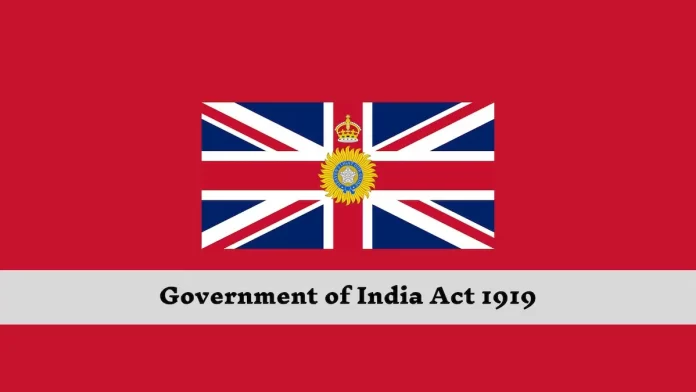The Government of India Act 1919 is a landmark legislation in the constitutional history of British India as it introduced many firsts. Read this to learn more.
Background
On August 20, 1917, the British Government declared, for the first time, that the object of the colonial rule was to gradually introduce a responsible government in British India.
The Government of India Act of 1919 was thus enacted and came into force in 1921. It was based on the recommendations of the Montagu-Chelmsford Reforms.
One may recall that Montagu was the Secretary of State for India and Lord Chelmsford was the Viceroy of India.
Key Features of the 1919 Act
Some key features of the Government of India Act 1919 include the following-
Council of States
The Government of India Act, 1919 provided for the creation of a “Council of States” as a second chamber of the Central legislature.
The Council actually came into existence in 1921 and the election was to be based on a restricted franchise comprising mainly the literate and propertied classes.
Thus, the origin of the Rajya Sabha or the Council of States can be traced to the Government of India Act 1919.
Demarcation of Central and Provincial subjects
It relaxed the central control over the provinces by demarcating and separating the central and provincial subjects.
The central and provincial legislatures were authorized to make laws on their respective list of subjects.
However, the structure of government continued to be centralized and unitary.
Separation of Central and Provincial Budgets
It separated, for the first time, provincial budgets from the Central budget and authorized the provincial legislatures to enact their budgets.
Dyarchy in Provinces
It further divided the provincial subjects into two parts – transferred and reserved.
The transferred subjects were to be administered by the governor with the aid of a council of ministers responsible to the Legislative Council. With this, the office of the Chief Minister or Premier also came into being.
The reserved subjects, on the other hand, were to be administered by the governor and his executive council without being responsible to the Legislative Council.
This dual scheme of governance was known as “dyarchy” – a Greek term. However, this experiment was largely unsuccessful.
With regard to local self-government, it became a transferred subject under the charge of a responsible Indian minister.
Bicameralism and Direct Elections
It introduced, for the first time, bicameralism and direct elections in the country.
Thus, the Indian Legislative Council was replaced by a bicameral legislature consisting of an Upper House (Council of States) and a Lower House (Legislative Assembly).
The majority of members of both the Houses were chosen by direct election. It required that the three of the six members of the Viceroy’s Executive Council (other than the commander-in-chief) were to be Indian.
Extension of Communal Representation
It extended the principle of communal representation by providing separate electorates for Sikhs, Indian Christians, Anglo-Indians, and Europeans.
Note that the Government of India Act 1909 had for the first time provided separate electorates for the Muslims.
Limited Franchise
It granted a franchise to a limited number of people on the basis of property, tax, or education.
Office of the High Commissioner for India
The Act created a new office of the High Commissioner for India in London and transferred to him some of the functions hitherto performed by the Secretary of State for India.
Public Service Commission
It provided for the establishment of a public service commission. Hence, a Central Public Service Commission was set up in 1926 for recruiting civil servants.
Basis of Simon Commission
The Government of India Act 1909 also provided for the appointment of a statutory commission to inquire into and report on its working after ten years of its coming into force.
That commission was constituted in 1927 and later came to be known as the Simon Commission.
100th year of Madras Legislative Council
Recently India commemorated the 100th year of the establishment of the Madras Legislative Council (MLC).
The MLC was established in 1921 under the Government of India Act 1919 and continued to function as the legislative assembly of the Madras state till 1969 and thereafter of Tamil Nadu.
It was set up under the Government of India Act 1919. Significantly, one seat in each territorial plural-member constituency was reserved for non-Brahmins.
However, the Indian National Congress boycotted this election and the strongly anti-Brahmanical Justice Party formed the government after the first election.
The newly constituted assembly is known for passing some historic and landmark laws that include-
- Abolition of the Devadasi system.
- Hindu Religious Endowment Act (1926)
- Voting rights for women (1921).
- Muthulakshmi Reddy was the first woman member of the Council.
- Issuing free pattas to the poor for housing sites.
